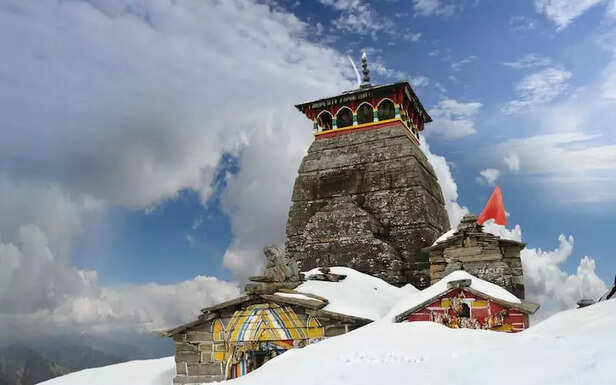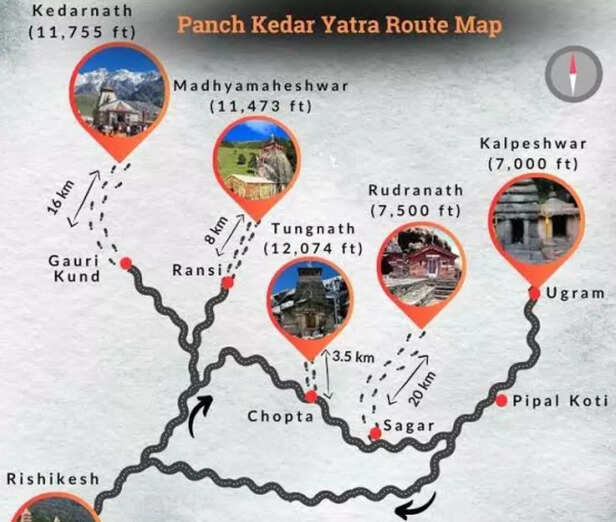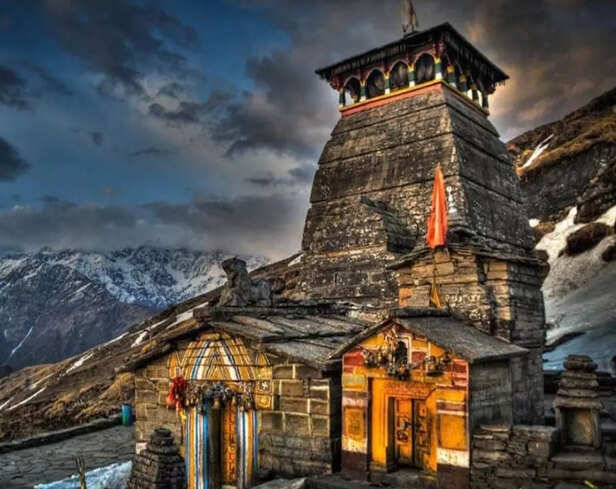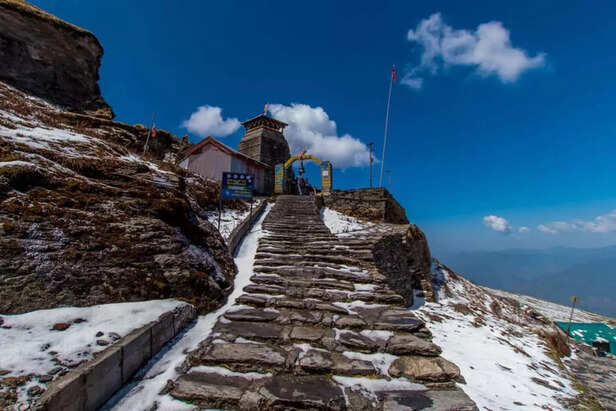Tungnath—Highest Shiva Temple in the World, Where the Arms of Shiva Embrace the Sky
Ankit Gupta | Apr 27, 2025, 13:14 IST
( Image credit : Timeslife )
Tungnath, nestled in the majestic Himalayas, holds the distinction of being the highest Shiva temple in the world. According to legend, the Pandavas sought Lord Shiva's forgiveness for the bloodshed after the Kurukshetra war. Shiva took the form of a bull to evade them and disappeared into the earth. Parts of his form later reappeared at five different places, where the Pandavas built temples to honor him — together known as the Panch Kedar. Tungnath is revered as the third temple among these sacred sites, believed to be the spot where Lord Shiva's arms emerged.
In the vast canvas of the Himalayas, where the clouds whisper secrets to the mountains and the winds carry ancient hymns, stands Tungnath — the highest Shiva temple in the world. At an astonishing altitude of approximately 3,680 meters (12,073 feet), Tungnath is not just a marvel of devotion, but also a testament to the timeless relationship between man and the divine.
Here, the thin mountain air seems to vibrate with an invisible presence, the sky appears within reach, and faith feels almost tangible.
Among the countless shrines dedicated to Lord Shiva, Tungnath holds a place of unique reverence. For it is said that here, the arms of Shiva himself emerged from the earth, blessing the devotees who braved the journey to seek him.
To understand Tungnath is not merely to visit a temple — it is to undertake a pilgrimage into the heart of a living legend.

The story of Tungnath is stitched into the grand tapestry of the Mahabharata. After the catastrophic war of Kurukshetra, the Pandavas — victors in battle yet burdened with guilt — sought redemption. Their hands were stained with the blood of kin and elders, and they knew that only Lord Shiva, the supreme purifier, could absolve them of their sins.
But Shiva, deeply displeased by the carnage, did not wish to grant them forgiveness easily. To avoid their entreaties, he took the form of a bull (some versions say Nandi himself) and disappeared into the earth at Kedarnath. Parts of his divine body then reemerged at five different places — the five Kedars — forming a sacred pilgrimage circuit.
At Tungnath, it is believed, his arms surfaced from the earth.
The word "Tung" means high, and "Nath" means lord — thus, Tungnath is quite literally the Lord of the Peaks. In reverence, the Pandavas are said to have constructed temples at each site, with Tungnath forming the third and central shrine in the Panch Kedar pilgrimage.
Thus, Tungnath stands not just as a temple, but as an eternal mark of Shiva’s elusive grace and the Pandavas’ desperate longing for forgiveness.

Tungnath is intrinsically woven into the sacred geography of Panch Kedar — the five temples where Shiva’s body parts manifested:
Pilgrims traditionally visit the Panch Kedar temples in a specific sequence, beginning with Kedarnath and moving progressively through the rest — with Tungnath being the serene middle point where weary bodies and restless souls find a moment of deep peace.
The Panch Kedar pilgrimage is not merely a religious ritual; it is a journey through physical endurance, spiritual aspiration, and mythological reverence.
What makes Tungnath truly special is its spiritual atmosphere. At such a high altitude, the temple is often enveloped by clouds, mist, and the purest winds. One feels stripped of worldly burdens, face-to-face with the primal forces of nature and divinity.
The arms emerging at Tungnath symbolize divine protection and the embracing compassion of Shiva.
It reminds devotees that while Shiva may seem distant and aloof — meditating atop icy peaks — his arms are forever extended to those who seek him with sincerity.
Moreover, the arduous climb to Tungnath becomes a metaphor for the spiritual journey:
Though wrapped in legend, Tungnath’s antiquity is real and deep. Historians and archaeologists suggest that the temple may be over 1,000 years old, constructed during the reign of the Katyuri kings, who were great patrons of art, architecture, and spirituality in the region.
The temple has withstood centuries of snowstorms, landslides, and isolation. Even today, it remains relatively untouched by modernity.
Local communities, particularly the priests from the Makkumath village, have preserved the sacred traditions with devotion.
Each summer, after a ceremonial reopening (usually in May), rituals and daily worship begin anew, connecting present-day pilgrims with ancient seekers who once walked the same paths.
When winter descends, Tungnath is buried under snow, and the deity is ceremoniously shifted to Makkumath for worship, ensuring that the flame of devotion never extinguishes.

Tungnath Temple stands as a quiet marvel of Himalayan architecture — humble yet majestic.
Despite its exposure to harsh weather, the structure remains incredibly resilient — a reflection, perhaps, of the indestructible spirit of faith itself.
Inside the sanctum, the silence feels alive — every prayer uttered, every tear shed, seems to hang in the cold, sacred air.

The journey to Tungnath is a pilgrimage in every sense.
The trek begins from Chopta, a serene hamlet often called the "Mini Switzerland of India."
The path winds through lush meadows, rhododendron forests, and snow-capped vistas that seem almost unreal. Birds sing hymns, the winds whisper prayers, and every step feels guided by unseen blessings.
At about 1 km from Tungnath, the mighty Chandrashila peak also beckons. Pilgrims often push further to Chandrashila to witness a breathtaking 360-degree view of some of the most majestic Himalayan peaks — including Nanda Devi, Trisul, and Kedar Dome.
Best time to visit:
At Tungnath, the soul transcends religious identity.
Here, meditating under the open sky, one realizes that Shiva is not merely a deity carved in stone.
He is the wind that howls across the peaks, the sun that kisses the mountains, the silence that hums in your chest.
Yogis and sages have long chosen these Himalayan heights for tapasya (spiritual austerities) because the environment itself accelerates inward journeys.
Thoughts slow down. Ego dissolves.
What remains is a raw, unfiltered connection to existence itself.
Tungnath teaches us that the true temple is not just built with stone — it is built with endurance, humility, and surrender.
In a world increasingly obsessed with speed, noise, and material success, places like Tungnath stand as beacons of the eternal.
Here, above the clouds, the arms of Shiva continue to embrace every soul that dares to seek him.
Tungnath is not merely a temple — it is a reminder:
At Tungnath, the seeker and the sought are one.
The journey may begin with footsteps on stone, but it ends in the boundless temple of the heart — where Shiva forever dwells.
Here, the thin mountain air seems to vibrate with an invisible presence, the sky appears within reach, and faith feels almost tangible.
Among the countless shrines dedicated to Lord Shiva, Tungnath holds a place of unique reverence. For it is said that here, the arms of Shiva himself emerged from the earth, blessing the devotees who braved the journey to seek him.
To understand Tungnath is not merely to visit a temple — it is to undertake a pilgrimage into the heart of a living legend.
The Legend Behind Tungnath

Heavenly Abode
( Image credit : Timeslife )
The story of Tungnath is stitched into the grand tapestry of the Mahabharata. After the catastrophic war of Kurukshetra, the Pandavas — victors in battle yet burdened with guilt — sought redemption. Their hands were stained with the blood of kin and elders, and they knew that only Lord Shiva, the supreme purifier, could absolve them of their sins.
But Shiva, deeply displeased by the carnage, did not wish to grant them forgiveness easily. To avoid their entreaties, he took the form of a bull (some versions say Nandi himself) and disappeared into the earth at Kedarnath. Parts of his divine body then reemerged at five different places — the five Kedars — forming a sacred pilgrimage circuit.
At Tungnath, it is believed, his arms surfaced from the earth.
The word "Tung" means high, and "Nath" means lord — thus, Tungnath is quite literally the Lord of the Peaks. In reverence, the Pandavas are said to have constructed temples at each site, with Tungnath forming the third and central shrine in the Panch Kedar pilgrimage.
Thus, Tungnath stands not just as a temple, but as an eternal mark of Shiva’s elusive grace and the Pandavas’ desperate longing for forgiveness.
Tungnath and the Panch Kedar Connection

Panch Kedar Routes
( Image credit : Timeslife )
Tungnath is intrinsically woven into the sacred geography of Panch Kedar — the five temples where Shiva’s body parts manifested:
- Kedarnath – Hump of Shiva’s bull form
- Tungnath – Arms
- Rudranath – Face
- Madhyamaheshwar – Navel and stomach
- Kalpeshwar – Hair
Pilgrims traditionally visit the Panch Kedar temples in a specific sequence, beginning with Kedarnath and moving progressively through the rest — with Tungnath being the serene middle point where weary bodies and restless souls find a moment of deep peace.
The Panch Kedar pilgrimage is not merely a religious ritual; it is a journey through physical endurance, spiritual aspiration, and mythological reverence.
Spiritual Significance of Tungnath
The arms emerging at Tungnath symbolize divine protection and the embracing compassion of Shiva.
It reminds devotees that while Shiva may seem distant and aloof — meditating atop icy peaks — his arms are forever extended to those who seek him with sincerity.
Moreover, the arduous climb to Tungnath becomes a metaphor for the spiritual journey:
- One must leave behind the comforts of the plains.
- One must endure trials — cold, breathlessness, fatigue.
- One must hold unwavering faith. Only then does one touch the divine.
History and Cultural Importance
The temple has withstood centuries of snowstorms, landslides, and isolation. Even today, it remains relatively untouched by modernity.
Local communities, particularly the priests from the Makkumath village, have preserved the sacred traditions with devotion.
Each summer, after a ceremonial reopening (usually in May), rituals and daily worship begin anew, connecting present-day pilgrims with ancient seekers who once walked the same paths.
When winter descends, Tungnath is buried under snow, and the deity is ceremoniously shifted to Makkumath for worship, ensuring that the flame of devotion never extinguishes.
The Temple Architecture

Rock Solid Material
( Image credit : Timeslife )
Tungnath Temple stands as a quiet marvel of Himalayan architecture — humble yet majestic.
- Built from grey stone slabs, the temple's simple design harmonizes with the rugged beauty of its surroundings.
- The main sanctum houses a Shiva lingam that is revered as the manifestation of Shiva’s arms.
- Smaller shrines dedicated to other deities, such as Parvati and the Pandavas, adorn the complex.
Despite its exposure to harsh weather, the structure remains incredibly resilient — a reflection, perhaps, of the indestructible spirit of faith itself.
Inside the sanctum, the silence feels alive — every prayer uttered, every tear shed, seems to hang in the cold, sacred air.
Trek to Tungnath – A Pilgrimage Journey

Inaccessible Trek
( Image credit : Timeslife )
The journey to Tungnath is a pilgrimage in every sense.
The trek begins from Chopta, a serene hamlet often called the "Mini Switzerland of India."
- Distance: Approximately 3.5 kilometers (one way)
- Difficulty: Easy to moderate (suitable for beginners)
The path winds through lush meadows, rhododendron forests, and snow-capped vistas that seem almost unreal. Birds sing hymns, the winds whisper prayers, and every step feels guided by unseen blessings.
At about 1 km from Tungnath, the mighty Chandrashila peak also beckons. Pilgrims often push further to Chandrashila to witness a breathtaking 360-degree view of some of the most majestic Himalayan peaks — including Nanda Devi, Trisul, and Kedar Dome.
Best time to visit:
- May–June: Clear weather, vibrant flora.
- September–November: Post-monsoon clarity, fewer crowds. (Avoid winter unless you are an experienced trekker — the temple remains closed under heavy snow.)
Tungnath Beyond Religion – A Spiritual Experience
Here, meditating under the open sky, one realizes that Shiva is not merely a deity carved in stone.
He is the wind that howls across the peaks, the sun that kisses the mountains, the silence that hums in your chest.
Yogis and sages have long chosen these Himalayan heights for tapasya (spiritual austerities) because the environment itself accelerates inward journeys.
Thoughts slow down. Ego dissolves.
What remains is a raw, unfiltered connection to existence itself.
Tungnath teaches us that the true temple is not just built with stone — it is built with endurance, humility, and surrender.
In a world increasingly obsessed with speed, noise, and material success, places like Tungnath stand as beacons of the eternal.
Here, above the clouds, the arms of Shiva continue to embrace every soul that dares to seek him.
Tungnath is not merely a temple — it is a reminder:
- That redemption is possible even after the gravest mistakes.
- That divinity awaits beyond the hardest journeys.
- That surrender is not weakness, but the highest strength.
At Tungnath, the seeker and the sought are one.
The journey may begin with footsteps on stone, but it ends in the boundless temple of the heart — where Shiva forever dwells.
